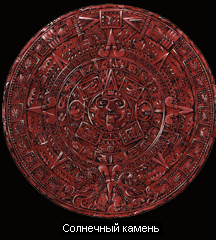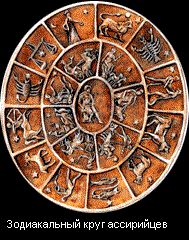The Calendar of Bloody A.tecs.
Living in Central Mexico from the XII century to the being of
the XVI century warlike A.tecs devoted much time to sciences including astronomy.
For needs of agriculture A.tecs, using the knowledge received
from the forecomers, developed the exact calendar system. 52 years of the moon-and-the sun
cycle formed the basis of it (something like our conception of "a century").
During the last 5 "miserable" days of 52-nd year a.tecs closed themselves at
homes put out all the lights and waited for a daybreak of the new cycle in order to flare
a New Light.
 A.tecs year was divided into 18
months with 20 days each. At the end of a year they added the mentioned
"miserable" days. Not only each month but even each day had their own names: the
first day - "alligator", the second day - "wind", the third -
"house", etc. Besides A.tecs had names for each hour of a day and night. They
were connected with the namesof Gods.
A.tecs year was divided into 18
months with 20 days each. At the end of a year they added the mentioned
"miserable" days. Not only each month but even each day had their own names: the
first day - "alligator", the second day - "wind", the third -
"house", etc. Besides A.tecs had names for each hour of a day and night. They
were connected with the namesof Gods.
In 1790 in Mexico A.tecs calendar, in a form of a basalt
disk, was found. It was 3,7 m in diameter and its weight was 24 t. There were special
signs on this stone pictures showed 20 a.tecs days 4 eras (of the seen) and two turquoise
dragons - the ancient sky symbols. "The Sun Stone" was a symbol of Olimpic Games
in Mexico in 1968.
Mesopotamian astronomy.
Blossom of Mesopotamian astronomy falls on the I thousand of
years B.C. In 612 B.C. the capital of Assiria (Ninevia) was ruined by the babylonian
troops. Later an archaeologists found a lot of earthenware "books" of assirians
priest-astronomers in the ruins of the palace of the last assirian tsar Ashurbanipal.
There was a result of all forecoming development of astronomy. Apart from catalogue of
stars and constellations and their morningrise data list those "books" included
a list of" constellation in the Moon way", that is 18 constellations - a
prototype of modern zodiac.
Messopotamia was covered by the net of temples, where they
carried astronomical investigations. From the VIII-th century B.C. astronomers began to
registrate the dates of observed Moon eclipses in special lists. Just the knowledge about
ancient eclipses allowed Gipparch, Ptolemei and Copernic calculate with more accuracy the
year duration.
These ancient scientists observations are actual even
nowadays but there is understandment of lack of accuracy in their measurement in detecting
distance between the Sun and the "basic" stars. There main astronomical tool was
a water watch. Mesopotamian astronomers divided a day (24 hours) into 12 hours and every
hour was divided into 30 "time degrees". One time degree had four our minutes.
 The most outstanding achievement of mesopotamian
astronomy became the development of mathematic theory, helped to foremeasure the Moon and
the planet moving with exactness enough for the naked eyed measurements.
The most outstanding achievement of mesopotamian
astronomy became the development of mathematic theory, helped to foremeasure the Moon and
the planet moving with exactness enough for the naked eyed measurements.
During this epoch on a basis of long time observations it was
discovered saros (Greek "repetition") i.e. 18-year period of the repeated Moon
eclipses. It was also found the periodical law-governed nature of the planet movement. The
classical scientists used the achievements of mesopotamian science.
 A.tecs year was divided into 18
months with 20 days each. At the end of a year they added the mentioned
"miserable" days. Not only each month but even each day had their own names: the
first day - "alligator", the second day - "wind", the third -
"house", etc. Besides A.tecs had names for each hour of a day and night. They
were connected with the namesof Gods.
A.tecs year was divided into 18
months with 20 days each. At the end of a year they added the mentioned
"miserable" days. Not only each month but even each day had their own names: the
first day - "alligator", the second day - "wind", the third -
"house", etc. Besides A.tecs had names for each hour of a day and night. They
were connected with the namesof Gods. The most outstanding achievement of mesopotamian
astronomy became the development of mathematic theory, helped to foremeasure the Moon and
the planet moving with exactness enough for the naked eyed measurements.
The most outstanding achievement of mesopotamian
astronomy became the development of mathematic theory, helped to foremeasure the Moon and
the planet moving with exactness enough for the naked eyed measurements.